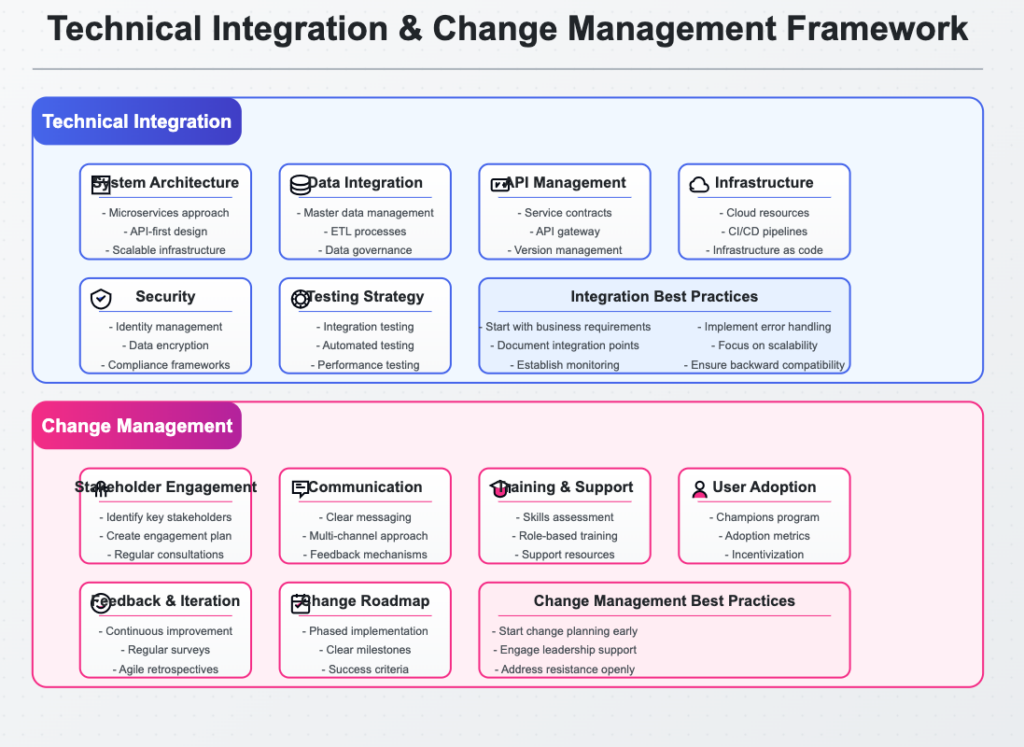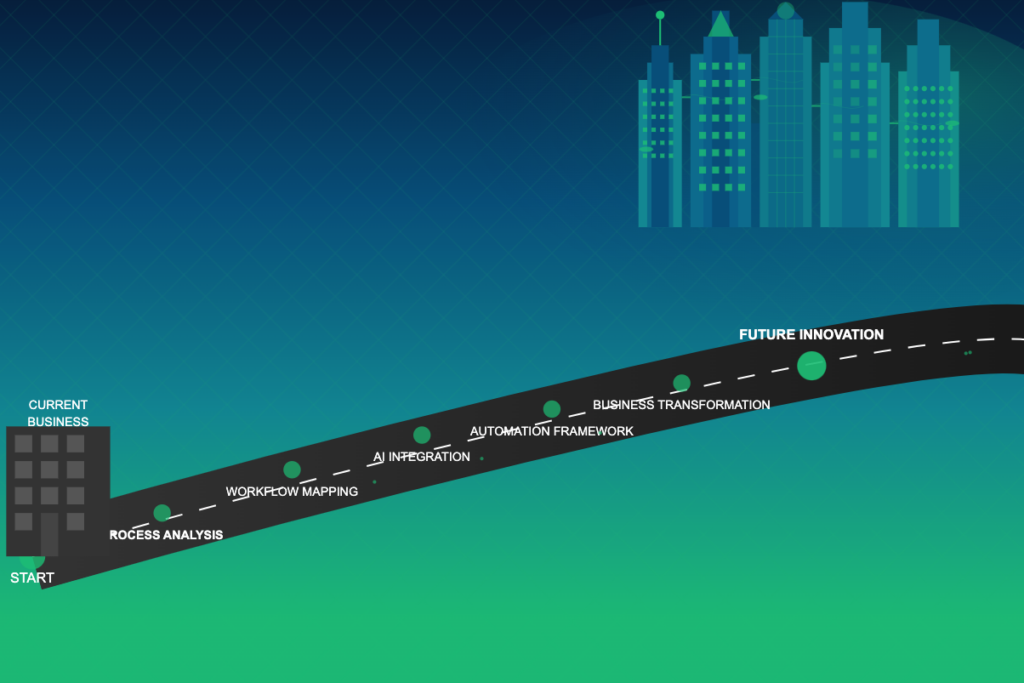Every hour spent on repetitive tasks is an hour taken away from strategic growth and innovation. For decision-makers, the opportunity cost of manual processes has never been higher—this is where AI workflow automation proves transformative. By streamlining up to 80% of routine tasks, AI not only improves accuracy and efficiency but also frees leaders to focus on high-impact initiatives.
The shift isn’t just operational; it’s psychological. Automated workflows reduce stress, simplify decision-making, and create room to pursue big-picture goals. From seamless system integration to measurable ROI, leveraging AI-powered solutions positions businesses to scale efficiently and stay competitive.
Ready to unlock this potential? Let’s explore how you can automate workflows with AI and revolutionize your business operations.
Key Takeaways
- Transformative Impact: AI workflow automation revolutionizes business operations by reducing manual tasks up to 80% while improving accuracy and consistency across processes.
- Strategic Benefits: Beyond operational efficiency, AI automation reduces decision-maker stress and enables leaders to focus on strategic initiatives rather than routine operations.
- Implementation Approach: Successful AI workflow automation requires a phased rollout, starting with high-impact, low-risk processes before scaling to more complex operations.
- ROI Optimization: Organizations typically see positive returns within 6-12 months through reduced labor costs, improved productivity, and fewer operational errors.
- Integration Capabilities: Modern AI workflow solutions offer seamless integration with existing systems, minimizing disruption to current operations while maximizing efficiency gains.
- Change Management: Effective implementation includes comprehensive training and clear communication strategies to ensure employee buy-in and smooth adoption.
- Scalability Features: AI-powered workflows adapt to growing business needs, automatically adjusting to increased workloads and evolving process requirements.
- Security Considerations: Enterprise-grade AI automation platforms include robust security measures and compliance features to protect sensitive business data.
- Competitive Advantage: Early adopters of AI workflow automation gain significant market advantages through faster operations, reduced costs, and enhanced customer experience.
Automating workflows with AI represents a significant opportunity for enterprise leaders to transform their operations. By implementing artificial intelligence solutions, businesses can reduce manual tasks, improve accuracy, and gain a competitive edge in today’s digital landscape. This comprehensive guide explores how to automate workflows with AI, providing actionable insights for IT Directors, Digital Transformation Leaders, and Business Owners looking to leverage this technology effectively.
Understanding AI Workflow Automation

AI workflow automation combines artificial intelligence capabilities with traditional automation to create intelligent systems that can learn, adapt, and make decisions with minimal human intervention. Unlike conventional automation that follows rigid, predefined rules, AI-powered automation can handle complex, variable processes by recognizing patterns, understanding context, and continuously improving performance.
The key components of AI workflow automation include:
- Machine learning algorithms that identify patterns and make predictions
- Natural language processing for understanding and generating human language
- Computer vision for interpreting visual information
- Decision engines that apply AI insights to workflow decisions
- Integration capabilities that connect with existing business systems
Traditional business process automation typically handles structured, repetitive tasks with clear rules. In contrast, AI automation for business can manage unstructured data, adapt to changing conditions, and handle exceptions without human intervention. This fundamental difference enables AI to automate more complex workflows that previously required human judgment.
For example, while traditional automation might route customer emails based on simple keywords, AI automation can understand customer intent, sentiment, and context to provide appropriate responses or route issues to the right department, even when dealing with previously unseen scenarios.
Benefits of AI Workflow Automation
Implementing AI-powered workflow tools delivers transformative advantages across enterprise operations. Organizations that successfully deploy AI automation typically report reducing manual tasks by up to 80%, allowing employees to focus on higher-value activities that require creativity, strategic thinking, and human interaction.
AI automation significantly improves accuracy and consistency across business processes. By eliminating human error and applying consistent decision-making criteria, companies experience fewer mistakes, reduced rework, and more predictable outcomes. A financial services firm implementing AI for document processing reported a 93% reduction in errors while processing three times the volume of transactions.
Beyond operational improvements, AI workflow automation provides strategic advantages by:
- Reducing decision-maker cognitive load and stress
- Freeing leadership time for innovation and strategic initiatives
- Enabling faster response to market changes and opportunities
- Providing data-driven insights for continuous improvement
According to McKinsey research, companies that extensively adopt AI automation report 40% higher productivity and 50% faster time-to-market for new products and services compared to industry peers.
The benefits of AI automation for business operations extend beyond cost savings to create competitive advantages through enhanced agility, improved customer experiences, and accelerated innovation cycles.
Top AI Workflow Automation Tools
The market offers numerous AI workflow automation solutions designed for enterprise needs. Leading platforms combine powerful AI capabilities with user-friendly interfaces and robust integration options. Here’s an overview of the top contenders:
Enterprise-Grade AI Automation Platforms
- UiPath: Combines RPA with AI for end-to-end process automation, featuring document understanding and conversational AI
- IBM Watson Orchestrate: Offers AI-powered automation with natural language processing and integration with enterprise systems
- Microsoft Power Automate: Provides low-code automation with AI Builder capabilities for document processing and prediction
- Automation Anywhere: Features IQ Bot for intelligent document processing and Discovery Bot for process mining
Specialized AI Workflow Solutions
- Zapier: Offers AI-enhanced workflow automation connecting 5,000+ apps with minimal technical expertise required
- Workato: Provides enterprise automation with AI-powered recipe suggestions and natural language interfaces
- Hyperscience: Specializes in intelligent document processing with machine learning capabilities
- Celonis: Combines process mining with AI to identify and automate optimization opportunities
When evaluating these tools, consider their integration capabilities with your existing technology stack. Most enterprise-grade solutions offer pre-built connectors for common business applications like Salesforce, SAP, Oracle, and Microsoft 365. Additionally, assess their AI capabilities, including machine learning models, natural language processing, and computer vision features that align with your specific use cases.
Implementing AI Automation in Business Processes
Successfully implementing business process automation with AI requires a strategic, phased approach. Organizations that achieve the best results typically start with high-impact, low-risk processes before expanding to more complex workflows.
Phase 1: Process Assessment and Selection
Begin by identifying processes that offer the highest potential return with manageable implementation complexity:
- Document-intensive processes (invoice processing, contract management)
- High-volume, repetitive tasks (data entry, report generation)
- Customer service interactions (inquiry handling, support ticket routing)
- Data validation and quality control procedures
For each candidate process, assess current performance metrics, pain points, and potential automation benefits. Prioritize processes where AI can deliver significant improvements in speed, accuracy, or cost.
Phase 2: Integration Planning
Develop a detailed integration plan that addresses:
- Data requirements and sources
- System dependencies and API connections
- Security and compliance considerations
- Performance expectations and monitoring mechanisms
Successful AI process automation implementation requires close collaboration between IT, business units, and external vendors to ensure seamless integration with existing systems.
Phase 3: Skills Development and Training
Address potential skill gaps by:
- Identifying required AI and automation competencies
- Developing training programs for technical and business teams
- Creating clear documentation and support resources
- Establishing centers of excellence to share knowledge and best practices
A manufacturing company implementing AI workflow automation achieved 30% faster adoption by establishing a dedicated training program and creating process-specific user guides before deployment.
Optimizing ROI with AI Automation
Organizations implementing AI workflow automation typically see a return on investment within 6-12 months, though this timeline varies based on implementation scope and complexity. To maximize ROI, focus on both direct cost savings and productivity enhancements.
Direct Cost Reduction Strategies
AI automation delivers measurable cost savings through:
- Labor cost optimization: Reducing time spent on manual tasks by 60-80%
- Error reduction: Minimizing costly mistakes and rework (typically 30-50% reduction)
- Process acceleration: Completing workflows 3-10 times faster than manual methods
- 24/7 operation: Enabling continuous processing without overtime costs
A financial services organization automated its claims processing with AI, reducing processing costs by 75% while handling 3x the volume with the same staff.
Productivity Enhancement Approaches
Beyond direct savings, AI automation improves productivity by:
- Eliminating bottlenecks: Identifying and resolving workflow constraints
- Improving decision quality: Providing data-driven insights for better outcomes
- Enabling self-service: Allowing stakeholders to initiate and track processes
- Reducing context switching: Automating routine tasks to maintain focus
To track ROI effectively, establish clear baseline metrics before implementation and monitor both quantitative measures (time savings, error rates, processing volumes) and qualitative factors (employee satisfaction, customer experience improvements).
Ensuring Successful Integration and Change Management

The success of AI workflow automation initiatives depends heavily on effective integration and change management strategies. Modern AI solutions offer sophisticated integration capabilities that minimize disruption to existing operations.
Technical Integration Best Practices
To achieve seamless technical integration:
- Use API-first platforms that connect easily with existing systems
- Implement a microservices architecture for modular, scalable automation
- Establish clear data governance policies for AI training and operation
- Create robust testing environments that mirror production conditions
- Deploy incrementally with continuous monitoring and refinement
A healthcare provider successfully integrated AI automation with their legacy systems by using an API gateway and implementing a phased deployment approach, achieving 99.8% system reliability from day one.
Organizational Change Management
Gaining employee buy-in requires a comprehensive change management approach:
- Clear communication: Explain how AI automation will benefit employees and customers
- Early involvement: Include end-users in the design and testing phases
- Skills development: Provide training on working alongside AI systems
- Success recognition: Celebrate early wins and share positive outcomes
- Feedback mechanisms: Create channels for ongoing improvement suggestions
Organizations that invest in change management report 30% higher adoption rates and 40% faster time-to-value for their AI automation initiatives compared to those that focus solely on technical implementation.
Scalability and Security Considerations
As enterprises expand their AI workflow automation initiatives, scalability and security become critical considerations. Successful implementations address both aspects from the planning stages.
Building Scalable AI Automation
AI-powered workflows must adapt to increasing business demands and process changes. Key scalability factors include:
- Cloud-based infrastructure: Providing flexible computing resources that scale with demand
- Containerization: Enabling consistent deployment across environments
- Modular architecture: Allowing components to be updated or replaced independently
- Horizontal scaling: Adding processing capacity to handle increased workloads
- Performance monitoring: Identifying bottlenecks before they impact operations
A retail organization built its AI automation platform on cloud infrastructure, allowing it to scale from processing 10,000 transactions daily to over 100,000 during peak seasons without performance degradation.
Enterprise-Grade Security Measures
AI automation platforms must incorporate robust security measures, including:
- Data encryption: Protecting information at rest and in transit
- Access controls: Implementing role-based permissions and authentication
- Audit trails: Tracking all system actions for compliance and security
- Vulnerability management: Regular testing and patching of security issues
- AI ethics frameworks: Ensuring responsible use of artificial intelligence
Organizations should also consider regulatory compliance requirements specific to their industry, such as GDPR for personal data, HIPAA for healthcare information, or SOC 2 for service organizations. AI automation for developers includes built-in security features that address these requirements while maintaining flexibility.
Gaining a Competitive Advantage through AI Workflow Automation
Early adopters of AI workflow automation gain significant competitive advantages in their markets. These advantages manifest in multiple dimensions of business performance.
Market Differentiation Through AI
Organizations leveraging AI automation effectively can:
- Respond faster to market changes and customer needs
- Deliver higher-quality products and services with greater consistency
- Offer more personalized customer experiences at scale
- Develop innovative business models enabled by AI capabilities
A telecommunications company implemented AI-powered service provisioning, reducing activation time from days to minutes while improving accuracy by 87%. This capability allowed them to capture market share from competitors who were still using manual processes.
Customer Experience Enhancement
AI workflow automation directly impacts customer experience through:
- Faster response times to inquiries and service requests
- More accurate information delivery across all channels
- Proactive issue resolution before customers are affected
- Consistent service delivery regardless of volume fluctuations
A financial services firm implemented AI-powered loan processing, reducing approval times from weeks to hours while maintaining compliance and reducing errors. Customer satisfaction scores increased by 35%, and application abandonment rates dropped by 60%.
Case Study: Manufacturing Excellence Through AI
A global manufacturing company implemented AI workflow automation across its supply chain operations with impressive results:
- 40% reduction in inventory carrying costs
- 62% improvement in forecast accuracy
- 28% decrease in production downtime
- 35% faster new product introduction cycles
The company achieved these results by using AI to optimize inventory levels, predict maintenance needs, and streamline quality control processes. Their competitive position improved significantly, with market share growing 12% within 18 months of implementation.
Choosing the Right AI Automation Solution for Your Business
Selecting the optimal AI-powered workflow tools requires careful evaluation of your organization’s specific needs, technical environment, and strategic objectives. This assessment should consider both current requirements and future growth plans.
Key Evaluation Criteria
When assessing potential solutions, consider these critical factors:
- AI capabilities: The types and sophistication of AI technologies included (machine learning, NLP, computer vision)
- Integration options: Compatibility with existing systems and data sources
- Ease of use: Accessibility for both technical and business users
- Customization: Ability to adapt to your specific processes and requirements
- Scalability: The Capacity to grow with your automation initiatives
- Security features: Protection for sensitive data and processes
- Vendor stability: Financial health and market position of the provider
- Support and services: Available training, implementation assistance, and ongoing support
Organizations that conduct thorough evaluations based on these criteria report 35% higher satisfaction with their chosen solutions compared to those making decisions based primarily on cost or vendor reputation.
Aligning with Organizational Goals
AI revolution in workflow automation offers various approaches that should align with your strategic objectives:
- For cost reduction: Focus on solutions with strong ROI tracking and process optimization
- For innovation: Prioritize platforms with advanced AI capabilities and flexible development options
- For customer experience: Select tools with strong omnichannel capabilities and personalization features
- For compliance: Choose solutions with robust governance, audit trails, and industry certifications
A healthcare organization seeking to improve patient experiences while maintaining strict HIPAA compliance selected an AI automation platform with healthcare-specific compliance features and patient journey optimization capabilities, achieving both objectives simultaneously.
Navigating Challenges in AI Adoption
While automating workflows with AI offers substantial benefits, organizations must address several common challenges to ensure successful implementation and adoption.
Technology Integration Hurdles
Many enterprises struggle with integrating AI automation into existing technology ecosystems. Common challenges include:
- Legacy system compatibility: Older systems may lack modern APIs or data access methods
- Data quality issues: Inconsistent or incomplete data can limit AI effectiveness
- Technical debt: Existing workarounds and customizations may complicate integration
- Performance concerns: AI processing requirements may impact system responsiveness
To address these challenges, consider implementing middleware solutions, establishing data quality initiatives before automation, and conducting thorough performance testing. A phased approach that addresses one system or data source at a time often proves more successful than attempting comprehensive integration simultaneously.
Regulatory and Compliance Considerations
AI automation must operate within regulatory frameworks that vary by industry and region:
- Data privacy regulations (GDPR, CCPA, HIPAA) impact how AI can process personal information
- Industry-specific requirements may dictate documentation, validation, or human oversight
- Emerging AI regulations are introducing new compliance considerations
- Explainability requirements may necessitate transparent AI decision processes
Organizations successfully navigating these challenges typically establish governance frameworks that include legal and compliance stakeholders from the planning stages. They also implement monitoring systems that track regulatory changes and adjust automation accordingly.
Balancing Risks and Rewards
To maximize the benefits of AI automation while minimizing risks:
- Start with lower-risk processes to build experience and confidence
- Implement strong testing protocols before deploying to production
- Maintain human oversight for critical decisions and exceptions
- Create clear escalation paths when AI encounters unusual situations
- Continuously monitor performance against established baselines
A financial services organization successfully balanced these considerations by implementing AI automation for routine document processing while maintaining human review for high-value transactions and unusual patterns. This approach delivered 80% of the potential efficiency gains while minimizing compliance and operational risks.
Future Trends in AI Workflow Automation
The landscape of AI workflow automation continues to evolve rapidly, with several emerging trends poised to shape enterprise adoption in the coming years.
Hyperautomation Across Enterprise Ecosystems
Hyperautomation—the combination of multiple AI technologies, tools, and platforms—is expanding beyond individual processes to encompass entire business ecosystems. This approach integrates:
- Process mining and discovery to identify automation opportunities
- Multiple AI technologies working in concert (NLP, machine learning, computer vision)
- End-to-end orchestration across departmental boundaries
- Continuous intelligence through real-time analytics and adaptation
Organizations implementing hyperautomation report 40% greater operational efficiency compared to those using isolated automation solutions.
AI-Human Collaborative Workflows
Rather than replacing human workers, advanced AI automation is creating new collaborative models where:
- AI handles routine aspects while humans manage exceptions and creative elements
- Intelligent assistants provide real-time guidance to human workers
- Augmented intelligence enhances human decision-making with AI-generated insights
- Adaptive workflows shift tasks between AI and humans based on complexity
These collaborative models are showing 25-35% higher productivity than either fully automated or fully manual approaches for complex knowledge work.
Predictive Process Optimization
AI is moving beyond reactive automation to predictive optimization, where systems:
- Anticipate process bottlenecks before they occur
- Dynamically reallocate resources based on predicted demand
- Suggest process improvements based on pattern recognition
- Simulate alternative workflows to identify optimal approaches
Organizations implementing predictive process optimization report 30% fewer operational disruptions and 20% lower resource requirements compared to traditional automation approaches.
Low-Code Automation Platforms
The democratization of AI automation through low-code platforms is accelerating, enabling:
- Business users to create AI-powered workflows without deep technical expertise
- Rapid prototyping and iteration of automation solutions
- Wider participation in digital transformation initiatives
- Faster implementation of automation use cases
Enterprises adopting low-code AI platforms report 3- 5x faster implementation cycles and broader adoption across business units.
Ethical AI Governance Frameworks
As AI automation becomes more pervasive, organizations are implementing comprehensive governance frameworks that address:
- Bias detection and mitigation in AI decision-making
- Transparency and explainability of automated processes
- Ethical use guidelines for AI applications
- Regular auditing and validation of AI systems
These governance frameworks are becoming competitive differentiators, with 65% of consumers expressing a preference for companies that demonstrate responsible AI practices.
Conclusion: Transforming Business Through AI Workflow Automation

Automating workflows with AI represents a transformative opportunity for enterprises seeking to improve efficiency, reduce costs, and gain competitive advantages. By strategically implementing AI automation solutions, organizations can achieve significant operational improvements while positioning themselves for future innovation.
The journey to successful AI workflow automation requires careful planning, appropriate technology selection, and effective change management. Organizations that address these elements systematically report the highest satisfaction and return on investment from their automation initiatives.
As AI technologies continue to advance, the possibilities for workflow automation will expand, creating new opportunities for business transformation. Organizations that establish strong foundations now will be well-positioned to leverage these emerging capabilities.
Ready to explore how AI automation can transform your business workflows? Contact our team of experts today for a personalized consultation and discover how the right AI solution can address your specific business challenges.
Any Other Questions?
That wraps up the most popular questions we get, but fire away with any others!
Contact us to discuss your next development project!
References
Frequently Asked Questions
AI workflow automation is akin to having a precision-crafted machine that transforms manual inefficiencies into streamlined processes. By leveraging AI, businesses can revolutionize operational workflows, enhancing both productivity and efficiency. Here are the key aspects of automating workflows with AI:
- Process Simplification: AI helps simplify complex tasks by streamlining manual processes and eliminating bottlenecks, thereby increasing operational efficiency.
- Error Reduction: AI minimizes human error by automating data entry and other repetitive tasks, ensuring data accuracy and process reliability.
- Decision Support: AI provides real-time data analysis, enabling teams to make more informed decisions by leveraging actionable insights.
- Cost Efficiency: By automating routine tasks, AI workflow automation reduces operational costs while boosting overall business agility.
For example, Appian’s AI workflow automation has been instrumental in reducing friction and costs in processes like insurance claims, demonstrating the vast potential of AI in workflow optimization.
AI is not just a tool for automation; it’s a transformative force that can revolutionize how businesses operate. By harnessing AI’s power, companies can automate routine tasks, enhance decision-making, and improve customer experience. Here are some ways AI can be used for automation:
- Task Automation: AI can automate repetitive tasks, such as document processing and data entry, freeing human resources for more strategic work.
- Predictive Maintenance: AI can analyze equipment performance data to predict potential failures, reducing downtime and improving asset longevity.
- Efficiency Boost: AI workflow automation simplifies complex tasks, streamlines manual processes, and boosts overall organizational efficiency.
- Enhanced Decision-Making: Real-time data analysis by AI helps businesses make informed and timely decisions.
A case in point is IBM’s AI workflows, which are used in predictive maintenance to monitor equipment performance, illustrating AI’s role in automating critical operations.
AI is the master key that unlocks the door to automating routine tasks with precision and speed. By automating these tasks, businesses can redirect human capital towards strategic initiatives and innovation. Here’s how AI automates routine tasks:
- Reduction in Manual Labor: AI replaces manual tasks like data entry and document processing with automated systems, reducing labor costs.
- Improved Accuracy: AI minimizes errors by executing tasks with precision, ensuring that data is accurate and up-to-date.
- Increased Productivity: By automating routine tasks, teams can focus on complex and creative projects, leading to higher productivity levels.
- Enhanced Efficiency: AI workflow automation ensures that processes run smoothly and efficiently, reducing bottlenecks and enhancing overall workflow reliability.
For instance, AI-powered tools by Atera automate routine IT tasks, allowing technicians to focus on more critical challenges and improve response times by up to 99%.
Choosing the best AI tool for automation is like selecting the right brush for an artist – it depends on the canvas and the vision. Different tools excel in various areas, from IT operations to business workflows. Here are some considerations for selecting an AI tool:
- Compatibility and Integration: Ensure the AI tool integrates well with existing systems to avoid operational silos.
- Scalability: Select tools that can scale with business growth to maintain efficiency over time.
- Functionality Alignment: Match the tool’s capabilities with specific business needs, such as IT support or workflow optimization.
- User Experience: Opt for tools with intuitive interfaces to facilitate smooth adoption and user satisfaction.
For example, Appian’s platform is well-regarded for its ability to automate complex workflows, while Atera’s Action AI excels in IT service management automation.

